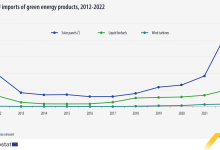Net-zero news
Harder-to-abate sectors in the spotlight
Yes, the world has just finished talking about this; we’re not a broken record mind you, but we do feel the need to insist on this one. We rehash the issue because it’s definitely a big deal. In a moment of make-or-break such as this one, it pays to insist on a topic. So again, we’re focusing on the possibility that net-zero emissions become a reality, the underlying process and implications and finally what it is that makes these hard-to-abate sectors (heavy industry sectors and heavy transport) tick and how we can use it to our advantage.
In a Tom Cruise-esque style, the Energy Transition Commission issued a mammoth like proportions report, properly entitled ‘Mission Possible’, in November, 2018. The think tank, made up of the foremost experts in energy production, energy usage, equipment supply, investing, NGOs and academics had but one goal in mind: stopping the global warming short in its tracks, and bringing it as close as possible to 1.5°C and as far as possible from 2°C. It might seem like a slight margin but it is a crucial one. The kicker is that in order to achieve this, we have to reach net-zero CO2 emissions by mid-century. Let’s talk feasibility!
As mentioned, the biggest challenge will be faced in the harder-to-abate sectors like the cement, steel, plastic and different heavy transportation methods. These are the big consumers of energy, not always clean one and they account for 30% of total global CO2 emissions. But thanks to innovative technologies there is a possibility and the report tells us that economically we’re fine: only 0.5% of global GDP will be required. But remember that each and every energy or industrial system will have to achieve net-zero by itself, no offsets purchasing from other sectors in the late stages. In the beginning at least, purchasing offsets from the land sector could prove valuable, in that companies could use that money for financing to support investments in more sustainable land use like preventing deforestation and facilitating reforestation.
According to the Energy Transition Commission, there are three sure-fire ways of dealing with our transport and industry carbon footprint. The first one consists in reducing the demand for carbon-intensive products and services by way of a circular economy (basically reusing and recycling as much as possible) and modal shifts (replacing transport means), as well as logistics efficiency. The second deals quite recurrently with energy efficiency and the third one takes on the deployment of decarbonization technologies across all sectors, with the most viable ones being: electricity, biomass, carbon capture and hydrogen.
Globally we could reduce the demand in the four major industry sectors (plastics, steel, aluminium, cement) by 40% and even by 56% in developed economies like Europe by 2050. In less developed areas it may take approximately 10 more years. But in order to realize this we need to use pre-existing materials better and reduce the materials requirements in key value chains like transport, buildings and consumer goods via improved designs for the products, a longer lifetime and new service-based and sharing business models, car sharing for example. Another example would be that of recycling in the cement industry: improved building design is said to reduce total demand by as much as 34%. Of course, this can only be achieved by better relationships between companies which cooperate in the value chain and stronger policies that create incentives. In transports the way to go would be switching from trucking to rail and shipping, and from short-haul aviation to high-speed rail which might deliver as much as a 20% reduction on emissions. But improved logistics efficiency and driving modal shifts will require greater cooperation between companies for the former, which will be facilitated by big data computing, and an improved public transport infrastructure for the latter.
In what pertains to energy efficiency, the biggest value it brings lies in the potential of reducing emissions from older industrial installations, particularly in developing countries. From the point of view of transportation, it seems there’s plenty of room for improvement: energy efficiency can be improved by 35 to 40% without radically changing the technology. Depending on future innovations, the percentage may even go higher especially in shipping and aviation as longer functionality for engines and vessel/airframe could mean a cost reduction by not switching to a new fuel.
If we refer to decarbonization, we need to take into account the specific location and available resource for each industry as prices for available zero-carbon electricity may vary. As such, a vital role is expected to be played by hydrogen but not only in the industrial areas: residential heat and flexibility provision in the power system. Thus, a significant investment in infrastructure may be required for the international trade of hydrogen and ammonia. Since renewable electricity is increasingly cost-competitive, in a matter of 15 years it will be possible to maintain electricity systems in which 85-90% of power is provided by wind and solar, combined with batteries for the short-term backup and peak technology like dispatchable hydro, biomass or fossil fuels with carbon capture. Speaking about carbon capture, it is likely to play a relatively reduced role in the power sector, but will nevertheless be essential in achieving total decarbonization in the cement, steel, chemicals and hydrogen production. Biomass will have to be tightly regulated, in order not to interfere with land use policies and agriculture, and will see its biggest influence in aviation where a zero-carbon equivalent of jet fuel is paramount to decarbonizing long-haul flights. Apparently, 42EJ of biomass would do the trick. In the transport sector the game changer will most likely be the electric drivetrain (with energy storage either in battery or hydrogen form) which will most likely replace the internal combustion engine. As electric trucks are likely to become cost-competitive with diesel and gasoline during the 2020s, there’s no need for natural gas and biofuel to be more than a transitional resource.
From the point of view of costs, it also looks good, with a total incremental capital investment from 2015 to 2050 of USD 5.5 to USD 8.4 trillion in the industrial sectors (equalling 0.1% of aggregate GDP over the mentioned period), less than 5% of business-as-usual investment in transport infrastructure and no major incremental investment in aviation and shipping. Of course, with the emergence of better, newer technologies, these costs could furthermore drop significantly. In regards to the final consumer, the impact on prices is expected to be rather small. The most significant increase would rear its head in aviation, a 10-20% increase in ticket prices may be required if biofuels and synthetic fuels remain significantly more expensive than conventional jet fuel. The cost may be felt by companies at the intermediate product level: zero carbon steel may cost 20% more per tonne than conventional steel. In the case of internationally traded intermediate products, international carbon prices and regulations should be the norm. Given these conditions, the harder-to-abate sectors should benefit from public support in order to continue innovation and investment strategies especially in long-distance power transmission, railway infrastructure, port and pipeline infrastructure and so on. However, there will no doubt be some winners and some losers in this transition, with local economic development and employment being affected. As we mentioned, the final consumer won’t take much of a hit but poorer households in developing countries may feel some backlash.
Of course, all this should be mitigated through timely transition policies which should also regulate international competition in order to avoid harmful effects or movement of production location due to high domestic carbon prices. Some solutions comprise: downstream taxes instead of upstream, border tax adjustments, free allocation within emissions trading schemes or compensation schemes. Furthermore, policy should count on the market to drive the research while it focuses on the already mentioned four complementary directions.
But even if money or policies are not an issue, as governments should push for the change via loan guarantees or reimbursable advances and public procurement, availability might be. Some of the technologies we crave are not yet on the market and some, for example cement kiln electrification, might not see the light of day for another decade. Also, while carbon capture technologies are employed today, they capture only 80-90% of the CO2 stream. In order for these technologies to become a staple for our fight against carbon emissions, both private investments and public policy need to be aligned. One of these massive investments will be in the transport sector via batteries and improvements in energy density, thus charging speed and battery life will become more important than cost reductions. Just by a battery density improvement of 2 to 3 times, electric vehicles will become dominant even for long-distance surface transport. For long-distance shipping and aviation, a 5 to 10 times increase would make electrification feasible. As we mentioned, cement kiln electrification would be a real game changer along with electric furnaces and further developments in electrochemistry for the steel and chemical industry. Speaking about the chemical industry, the emissions generated by industrial processes could be eliminated by way of electrification, biomass combustion or carbon capture or sequestration but the real end game would be figuring out what to do with end-of-life emissions produced in aviation, shipping, plastics and fertilizers. As such, scientists should focus on biochemistry, synthetic chemistry, hybrid chemical routes and chemical recycling of plastics. Developing new materials could also push the initiative further by using timber or pozzolan-based concrete in lieu of Portland cement or using cellulose-based fibres as a substitute for plastic.
Wining the climate war, just as any type of war, requires first and foremost having a united front. Whether or not the public, the government, companies and even small producers and consumers will come together under a common banner remains to be seen. The stakes however remain pretty high. And it would be a shame to not even try when we know victory is possible. After all, we try for the impossible on a daily basis.







